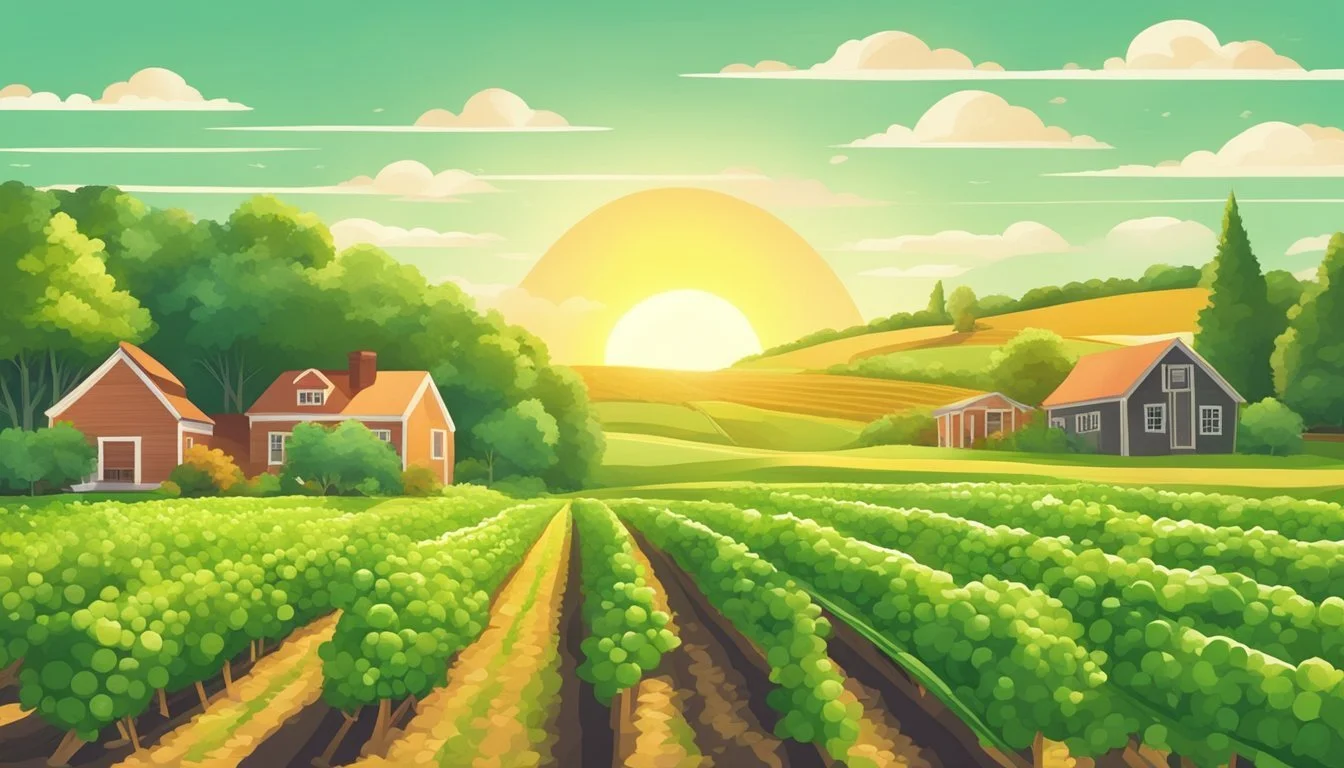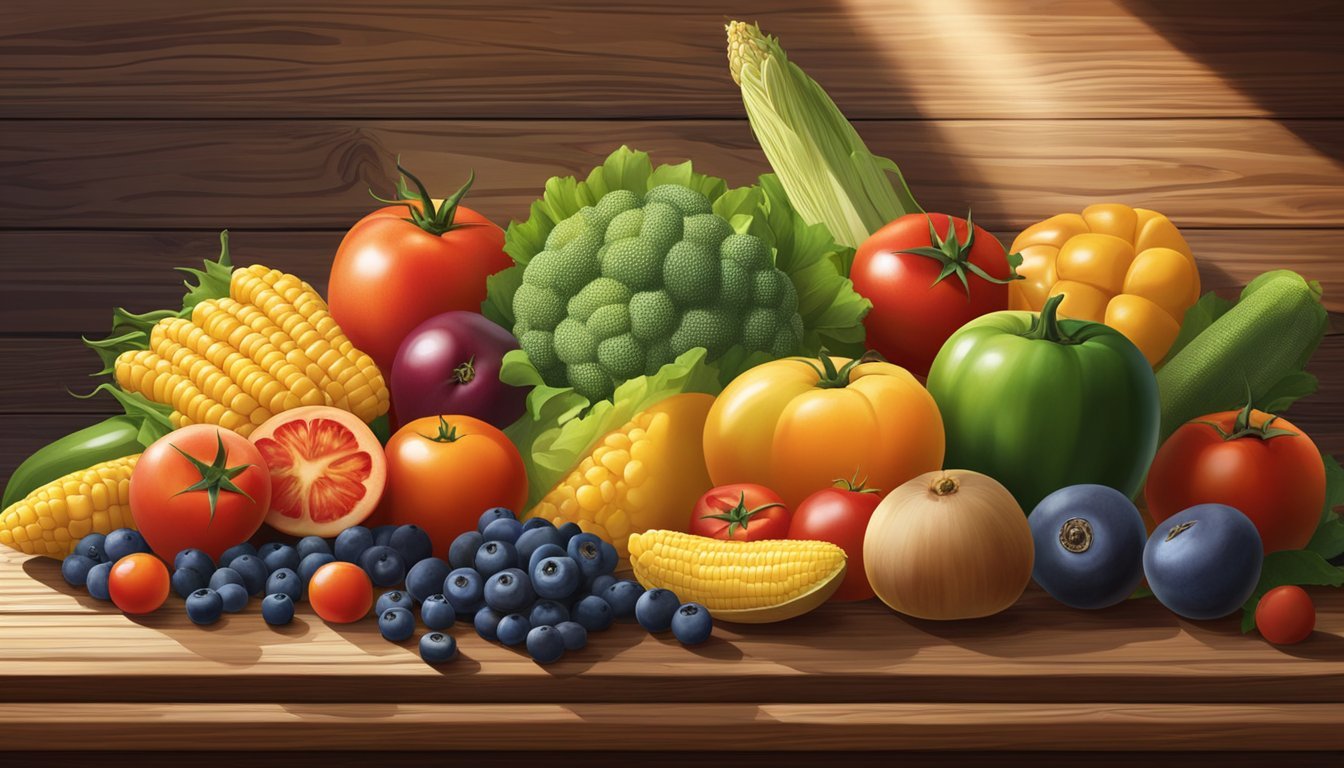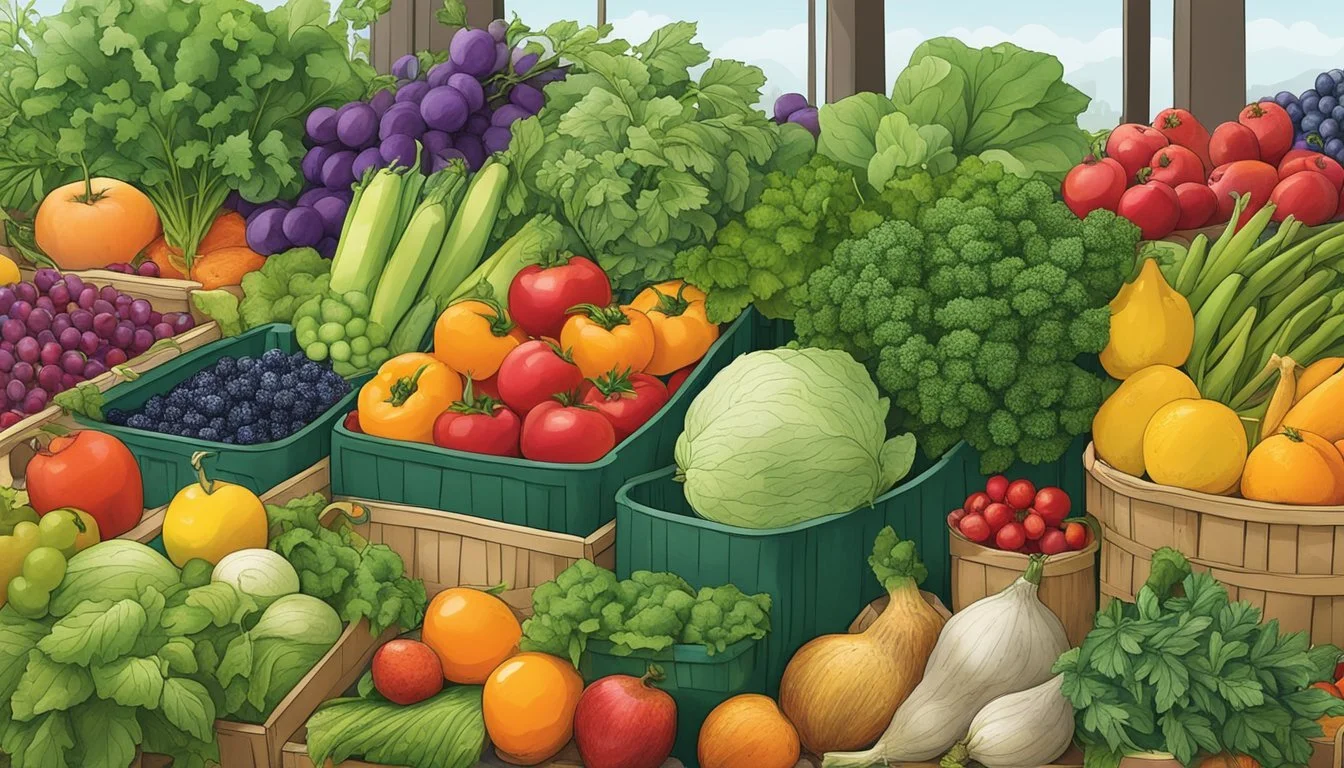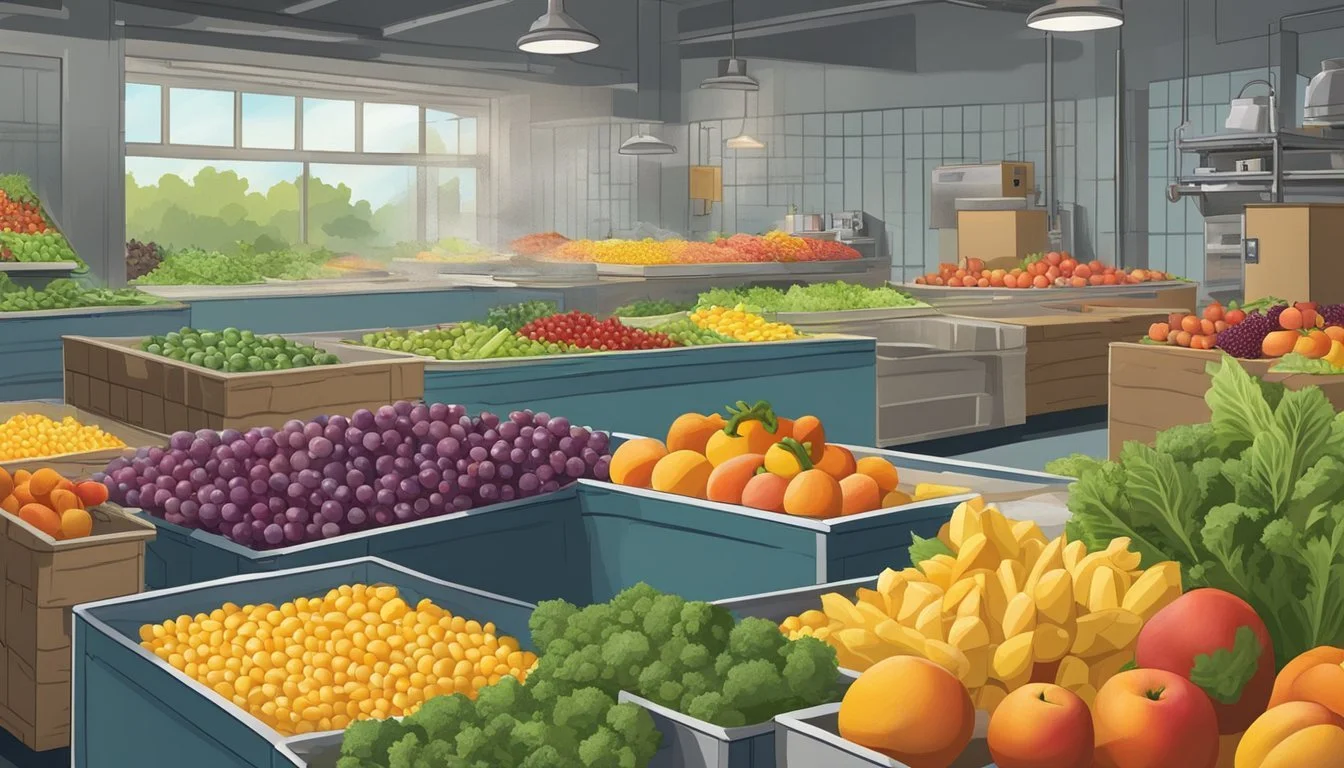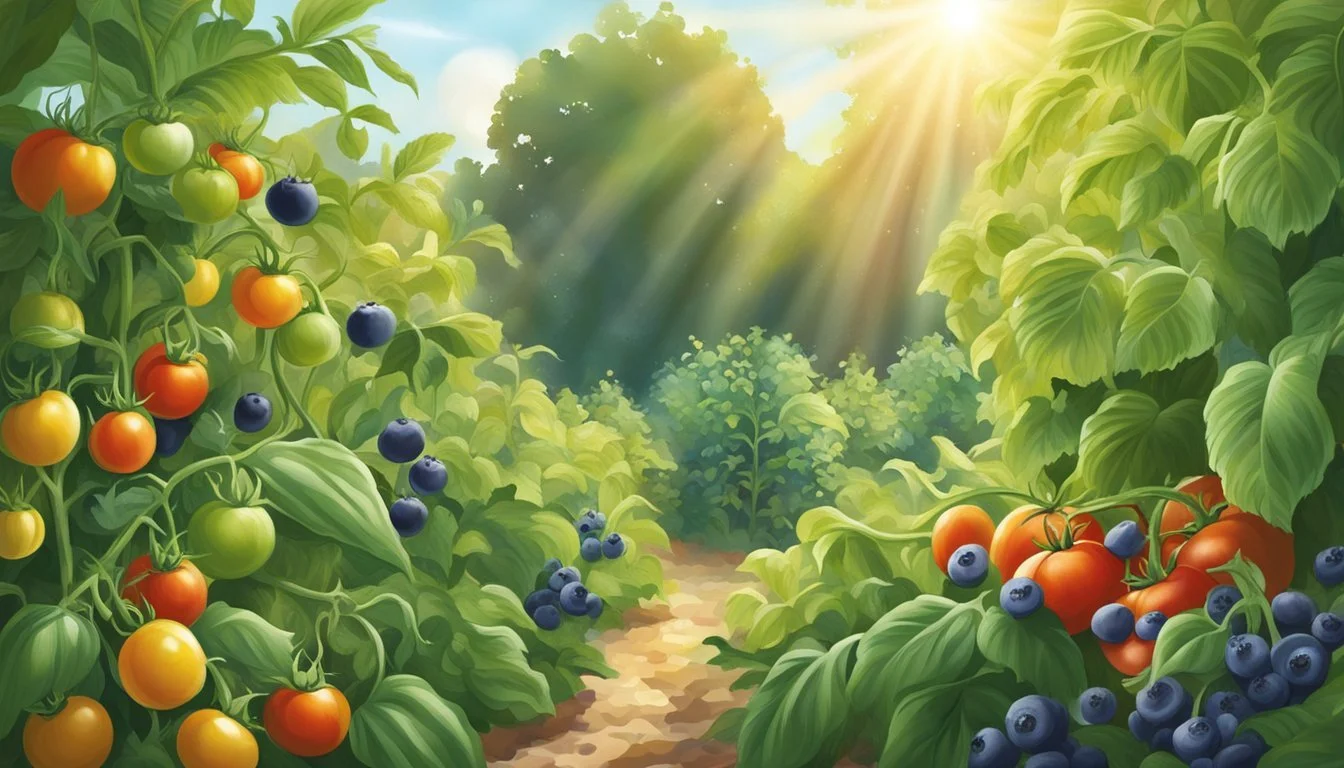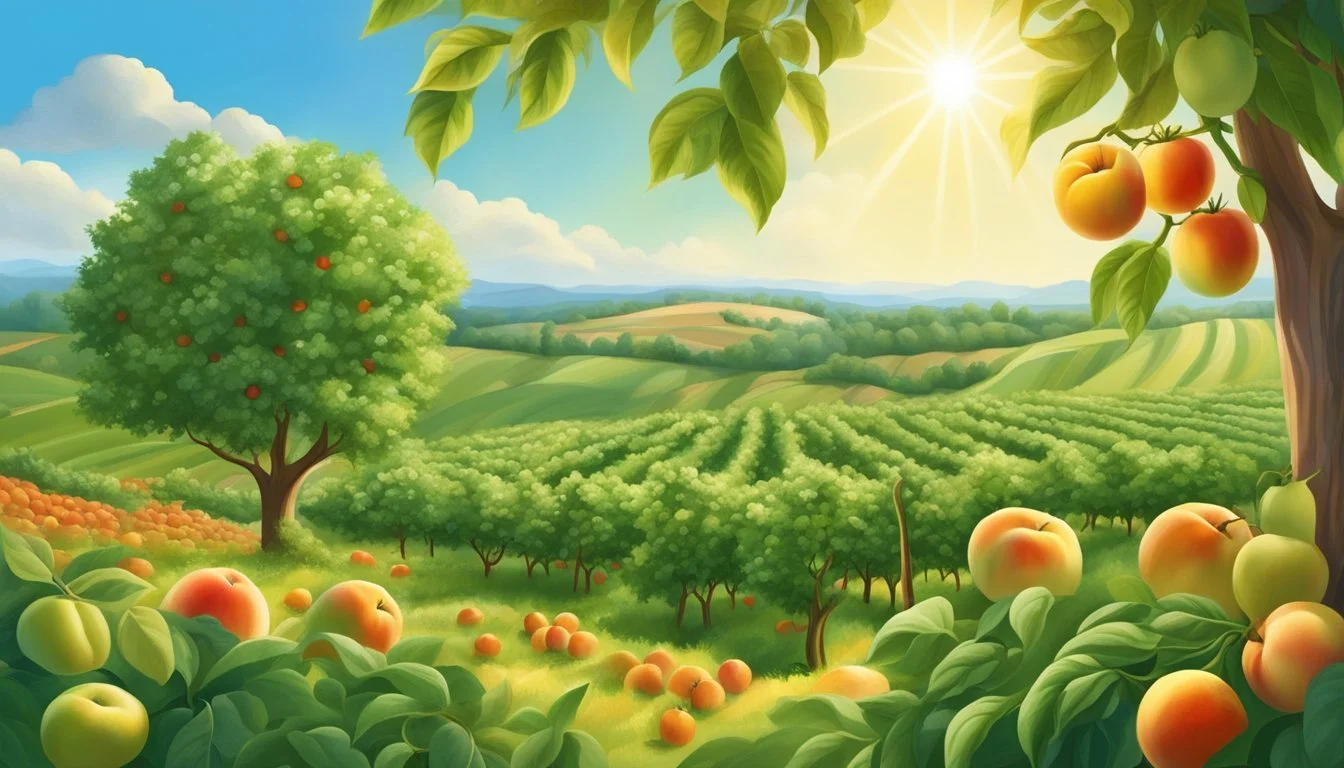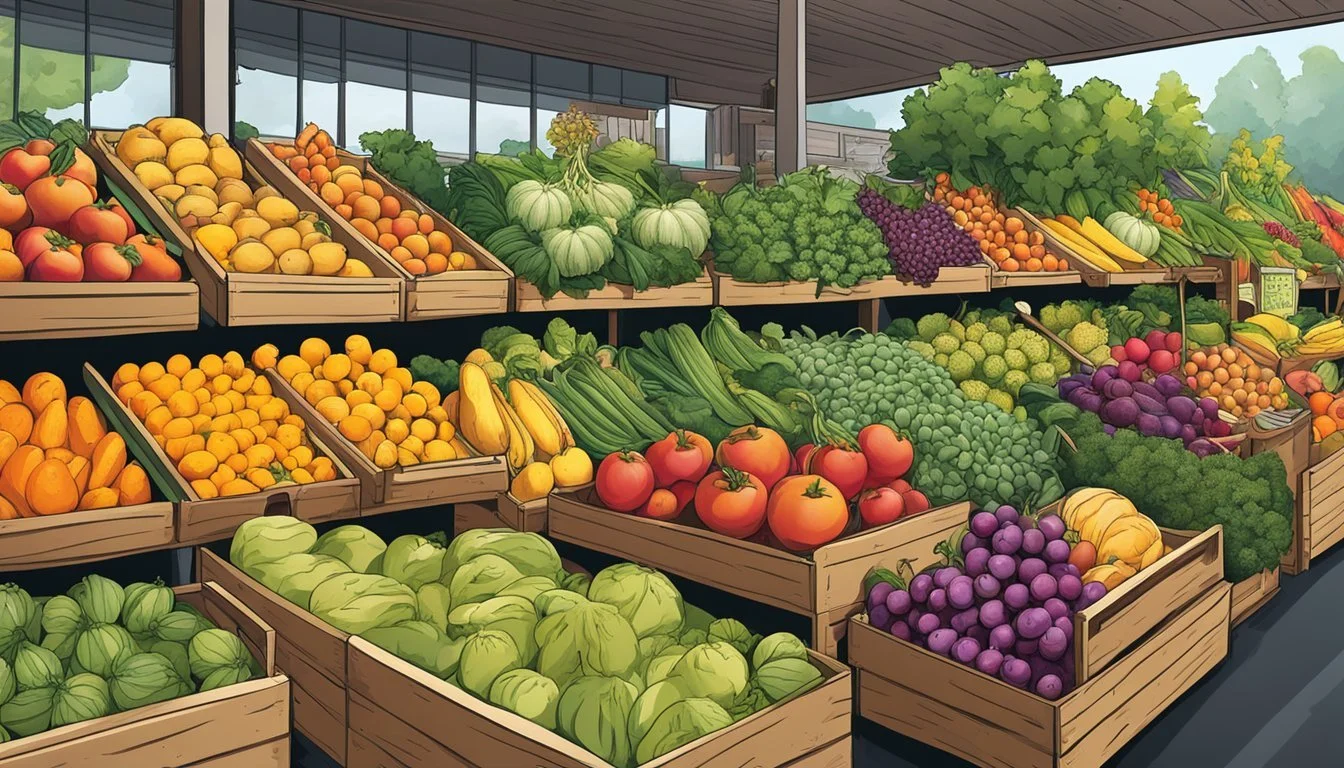Massachusetts Seasonal Fruit & Vegetables in August
Your Guide to Local Produce
This Article is Part of our Massachusetts Seasonal Fruit & Veg Calendar
In Massachusetts, the rolling farmlands and varying climate conditions contribute to a diverse harvest throughout the year, with August marking the peak season for many fruits and vegetables. During this month, locals and visitors alike have the opportunity to savor the fresh taste of produce picked at the height of ripeness. From the tangy sweetness of early apple varieties to the crisp crunch of fresh cucumbers, the offerings are both abundant and varied.
The state's agricultural calendar in August is particularly rich, featuring a variety of apples such as the Paula Red and Ginger Gold, each with its own distinctive flavor profile fit for both eating fresh and culinary use. In addition to apples, August is also a prime time for the harvesting of stone fruits like peaches, along with a medley of berries that continue to thrive from the earlier summer months. Vegetables are in no short supply, with corn (how long does corn last?), tomatoes, and green beans standing as staples that are widely available at local farmers markets and roadside stands.
The commitment to supporting local agriculture means that Massachusetts provides a vast range of seasonal delights that not only taste better but also have a smaller carbon footprint due to reduced transportation. Eating seasonally thus offers the dual benefit of enjoying produce at its nutritional and flavorful best, while also contributing to the local economy and sustainable practices within the community.
Overview of Massachusetts' Seasonal Produce
August in Massachusetts is a time of abundance in terms of fresh produce. The warm summer weather provides optimal growing conditions for a variety of fruits and vegetables. Consumers can find a bounty of local produce at farmers' markets, grocery stores, and roadside stands.
Fruits: The fruit harvest is in full swing. Apples start to come into season, with early varieties like Duchess of Oldenburg, Paula Red, and Red Gravenstein available. Other fruits that are typically ripe and ready to eat include:
Peaches
Blueberries (how long do blueberries last?)
Plums
Pears
Vegetables: This month also sees an array of vegetables reaching their peak. The following list represents some of the vegetables available:
Corn-on-the-cob: a staple at many summer barbecues
Tomatoes: available in various sizes and types
Zucchini (What wine goes well with zucchini?): a versatile summer squash
Eggplant (how long does eggplant last?): perfect for grilling or making ratatouille (What wine goes well with ratatouille?)
Peppers: ranging from sweet to hot
Green beans
Locally grown produce not only supports Massachusetts' agricultural economy but also offers consumers fresher options. When foods are grown and harvested locally, they require less time in transit, retaining more flavor and nutrients. Additionally, eating seasonally encourages a diverse diet and provides an opportunity to try new recipes featuring the freshest ingredients. It's an ideal time for individuals to enjoy the full palate of nature’s offerings in Massachusetts.
August's Harvest Calendar
August in Massachusetts is a peak time for a variety of fruits and vegetables, offering a bountiful harvest. This month ushers in the full splendor of the summer's yield with an array of vibrant and fresh produce.
Fruits:
Apples begin to make their appearance with varieties like Yellow Transparent, Lodi, and Paula Red.
By mid-August, Jersey Mac and Duchess of Oldenburg add to the selections.
Toward the end of the month, Wealthy and McIntosh apples become available.
Vegetables:
It's a good season for leafy greens such as lettuce and kale.
Root vegetables like beets and carrots are flourishing.
Corn continues to be a staple of summer with its sweetest ears ready for harvest.
In the orchards, apple varieties become the star of the season, while fields are scattered with greens and root vegetables, ensuring that there's a wide selection available. One finds local farm stands and markets teeming with fresh produce.
Produce Type Varieties/Items Available Fruits Apples (various types), Peaches, Plums Vegetables Corn, Tomatoes, Peppers, Cucumbers Greens Lettuce, Kale, Arugula Root Vegetables Beets, Carrots Cruciferous Broccoli, Cabbage
Residents eager to experience the freshest flavors of the season have ample opportunity to indulge in the state's local produce, which supports both a healthy living and local agriculture. August is a prime time for Massachusetts locals and visitors alike to experience the state's agricultural richness.
Highlight on Fruit
August in Massachusetts is bountiful with a variety of fresh fruits reaching their peak. This period is particularly notable for its harvest of berries and stone fruits, along with an abundance of grapes and melons.
Berries and Stone Fruits
In August, the berry harvest is in full swing. Blueberries, raspberries, and blackberries are abundantly fresh and can be found at local markets. They are known for their vibrant colors and sweet, sometimes tart, flavors. These berries are not only perfect for eating fresh but also ideal for jams, baking, or freezing for later use.
For stone fruits, this month sees a surge in the availability of peaches, nectarines, and plums. Their juicy flesh and sweet aromas make them highly sought after for fresh eating, desserts, and canning.
Blueberries: sweet, versatile, suitable for eating fresh or baking
Raspberries: slightly tart, ideal for desserts or as a topping
Blackberries: deep flavor, great for jams or syrups
Peaches: juicy, perfect for pies or eaten fresh
Nectarines: similar to peaches but with smooth skin
Plums: sweet with a hint of tartness, used in a variety of dishes
Grapes and Melons
Grapes in Massachusetts ripen towards the end of summer, and varieties can range from table grapes to those meant for wine production. They are a refreshing snack and can also be a delightful addition to salads or cheese platters.
Melon varieties such as watermelon, cantaloupe (how long does cantaloupe last?), and honeydew are also in season. Their refreshingly sweet and hydrating qualities make them favorites for picnics and summer desserts.
Grapes: can be eaten fresh or used in recipes
Watermelon: crisp texture, quintessential summer fruit
Cantaloupe: rich flavor, often served in fruit salads
Honeydew: subtle sweetness, pairs well with other fruits
Each of these fruits boasts its own distinct flavor and lends itself to a variety of culinary uses, making August a perfect time for fruit enthusiasts to enjoy the local harvest of Massachusetts.
Highlight on Vegetables
In August, Massachusetts offers a cornucopia of vibrant vegetables. They take advantage of the state's warm summer weather, boasting flavors that are as rich as their colors.
Nightshades and Cucurbits
Nightshades like tomatoes and eggplant are at their peak in August, displaying a spectrum of color from deep purples to bright reds. Chefs and home cooks alike celebrate their arrival for their freshness and depth of flavor. In the cucurbit family, squash, cucumbers, and zucchini are abundant. These vegetables are not only versatile in the kitchen but also provide a fresh, crisp quality to dishes.
Tomatoes: Bright red and bursting with flavor, they are perfect for sauces and salads.
Eggplant: With its rich purple skin, it's a great meat substitute or side dish when grilled.
Squash: A diverse vegetable, great in roasts or as a centerpiece in a stuffed dish.
Cucumbers: Crisp and refreshing, ideal for salads or as a cooling snack.
Zucchini: Mild-tasting with a delicate texture, excellent for frying or baking.
Roots and Greens
Moving to the earthier palate, root vegetables like carrots, radishes, and beets provide an array of color, from the bright orange of the carrots to the deep reds and purples of the beets and radishes. Each offers a distinct taste and crunch, ideal for raw salads or a sweet roasted vegetable medley. Greens such as chard, kale, and arugula (how long does arugula last?) are also in season, with their varying textures and degrees of peppery flavor, they can make any salad or side dish stand out.
Carrots: Deep orange hues, sweet and perfect for both raw and cooked preparations.
Radishes: Offer a peppery bite, making them a crisp addition to salads.
Beets: Earthy and rich, they can be roasted, boiled, or eaten raw.
Chard and Kale: Dark leafy greens ideal for hearty salads or sautéed as a side.
Arugula: Pepper-flavored leaves that enhance any green salad blend.
Herbs and Seasonal Flavors
August in Massachusetts beckons with an abundance of herbs that elevate the flavors of summer dishes. Among them, basil (how long does basil last?), parsley, and thyme stand out for their versatility and vibrant taste.
Basil, with its lush, green leaves, thrives in the warm August weather. It is a staple in pesto and pairs beautifully with tomatoes, another star of the season. Basil is also an essential ingredient in Italian cuisine and adds a fresh, peppery flavor to salads, pizzas, and pastas.
Basil varieties in season: Sweet Basil, Genovese Basil, Purple Basil
Parsley, both curly and flat-leaf, is abundant this time of year. It holds a more subtle flavor compared to basil, which makes it excellent for garnishing and incorporating into sauces and marinades. Parsley is not just a garnish; it contributes a clean, slightly bitter undertone that balances richer flavors.
Uses for parsley: Garnish, Chimichurri, Tabbouleh
Thyme is yet another herb that comes into its own during the late summer months. Its small, fragrant leaves are used to infuse dishes with a distinctly aromatic flavor that hints at mint and lemon. Popular in French cuisine, thyme is a component of the classic bouquet garni and is often added to roasts, stews, and soups.
Thyme's flavor profile: Earthy, Minty, Lemon undertone
Restaurant chefs and home cooks alike revel in the chance to use these fresh herbs in their August menus. They contribute not only to the aesthetic of a dish with their vibrant colors but also add depth and complexity to the flavor profile of seasonal produce.
Food Preparation and Storage Tips
When approaching the preservation and preparation of Massachusetts's seasonal fruits and vegetables in August, understanding how to gauge ripeness and leverage canning techniques are crucial for maximizing flavor and longevity.
Freshness and Ripeness
For fruits like blackberries, assessing freshness involves looking for a deep, uniform color. They should be plump and free of wrinkles, with a smooth surface that indicates peak ripeness. On the other hand, vegetables such as celery (how long does celery last?) should appear firm, not limp, with a bright color. Here are specific indicators:
Blackberries: Deep black color; avoid berries that are red or have dents.
Celery: Firm stalks and bright green leaves; avoid any with discoloration or wilt.
Fruits and vegetables at the peak of freshness should be stored properly. Blackberries, for example, are best kept in the refrigerator, while celery will maintain its crispness longer when wrapped in aluminum foil and refrigerated.
Canning and Preserving
Home preserving allows one to extend the enjoyment of August's harvest for months. Methods vary from simple freezing to more involved canning:
Freezing: Ideal for blackberries, which can be spread on a baking sheet to freeze before transferring to airtight containers, preserving their fresh flavor.
Canning:
Salsa: Fresh tomatoes, another August staple, can be transformed into salsa and sealed in jars for pantry storage.
Sauces: Similarly, roasted tomatoes can be puréed into sauces and canned.
Home preserving prompts safety considerations, as improperly canned foods can pose health risks. Adhering to time-tested canning practices is essential.
Note: The homemade preservation of celery is less common, but it can be chopped and frozen for later use in soups and stews. Celery should be blanched first to preserve its color and crispness.
Gardening and Crop Management
During August in Massachusetts, gardeners are typically in the midst of a busy harvest season. This month is characterized by robust crop availability, with many vegetables and fruits reaching peak maturity. Successful gardening and crop management hinge upon the understanding of local climatic conditions and the timing of plant growth cycles.
Gardening Strategies:
Gardeners should remain vigilant about watering, ensuring consistent moisture while avoiding waterlogging, which can be detrimental to root systems.
Regular weeding is essential for preventing unwanted plants from competing with crops for nutrients and light.
Managing Environmental Factors:
Rain Levels: Monitoring weather forecasts allows gardeners to adjust watering schedules in response to heavy rainfall or drought conditions.
Frost: While August is typically free from frost, being prepared for unseasonal weather changes with protective measures like row covers can safeguard crops.
Pest Control:
Pests are a persistent issue in August, and gardeners should inspect plants frequently for signs of infestation.
Implementing integrated pest management (IPM) strategies, which might include the use of natural predators or organic pesticides, can effectively control pest populations while minimizing environmental impact.
Crop Availability:
Fruit Vegetables Apples (early varieties) Corn-on-the-cob Peaches Tomatoes Blueberries Zucchini Green beans
In summary, gardeners in Massachusetts manage their August crops by being responsive to weather patterns, maintaining diligent care practices, and executing strategic pest control. Through these efforts, they can maximize the yield and quality of their produce.
Farmers Markets and Local Purchasing
In August, Massachusetts offers a plethora of farmers markets, serving as a prime location for purchasing local produce. They provide a vehicle for not only supporting the local economy but also for obtaining the freshest seasonal fruits and vegetables. Farmers markets spread across the state turn into bustling hubs where consumers can directly interact with the growers.
Visitors to these markets can expect to find a host of in-season produce, which typically includes:
Fruits: Apples, blueberries, peaches, plums, and raspberries
Vegetables: Corn, tomatoes, summer squash, green beans, and cucumbers
The Massachusetts farmers markets often welcome various forms of payment, promoting accessibility and convenience. Many locations accept SNAP/EBT, HIP, WIC, and senior farmers market coupons, ensuring that fresh, quality food is available to all members of the community.
Shopping at these markets not only offers fresh products but also contributes to reducing the carbon footprint associated with transportation of goods. Customers are benefiting from produce that has traveled a shorter distance, thus retaining more nutrients and flavor.
The following is a snapshot of where some local farmers markets can be found during the month of August:
City/Town Market Name Operating Times Boston Boston Copley Square Market Tuesdays and Fridays, 11am-6pm Cambridge Cambridge Central Square Mondays, 12pm-6pm Springfield Springfield Farmers Market Saturdays, 10am-2pm Worcester Worcester Main Street Market Thursdays, 11am-3pm
Massachusetts' farmers markets are an essential part of the state's commitment to sustainable farming and community health. They serve as a testament to the vibrant agricultural tapestry of the region and the dedication to a farm-to-table philosophy.
Health Benefits of Seasonal Eating
Eating seasonally offers various health benefits. When individuals consume fruits and vegetables that are in peak season, they often reap the advantages of enhanced flavor and nutritional value. The produce is typically harvested at its prime state of ripeness, which translates into higher levels of antioxidants, vitamins, and minerals for the consumer.
Nutritional Advantages:
Peak Ripeness: Fruits and vegetables in season are picked at the pinnacle of their freshness, ensuring optimal taste and nutrient content.
Diversity in Diet: Seasonal eating naturally rotates the diet, leading to a wider array of nutrients over time.
Improved Health:
Supports Immune Function: Seasonal produce can boost the immune system with their high levels of vitamins and antioxidants.
Aids Digestive Health: High-fiber seasonal vegetables support healthy digestion.
Seasonal Relevance:
Local Produce: Seasonal eating often means the produce is sourced locally, which could reduce the time from farm to table, helping to retain nutrients that might be lost in transit during other times of the year.
Month Seasonal Produce Known Nutrients August Tomatoes Vitamin C, Potassium Zucchini Vitamin A, Manganese Corn Fiber, Vitamin B6 Peaches Vitamins A and C
Eating with the seasons not only enhances an individual's diet through variety but also aligns with the natural growing cycle, which can lead to environmental benefits such as reduced transportation emissions and support for local agriculture.
Environmental Impact and Sustainability
Massachusetts' focus on seasonal produce in August not only supports local economies but also plays a significant role in sustainability and reducing environmental impact. Local harvests in August typically include:
Tomatoes: Juicy and ripe, they grow abundantly in the late summer.
Corn: Sweet and fresh, picked at the peak of its season.
Zucchini: A versatile vegetable, it thrives during this month.
Green Beans: Snappy and tender, a garden favorite.
Peppers: From sweet to spicy, they add flavor diversity.
Berries: A last flourish of blueberries and raspberries before the fall.
When consumers choose these seasonal offerings, they help decrease the ecological footprint associated with food production in several ways. Here are key considerations:
Reduced Transport: Local produce requires less transport, leading to lower greenhouse gas emissions.
Seasonal Harmony: Crops grown in season need less artificial intervention, minimizing the use of harmful pesticides and fertilizers.
Water Usage: Seasonal crops often align with natural rainfall patterns, resulting in more efficient water use.
Additionally, seasonal cultivation supports agricultural biodiversity by allowing the land to rejuvenate, fostering a range of species to thrive. Consumers benefit from the rich and varied nutrients provided by a diverse, seasonal diet.
These steps, while seemingly small, can cumulatively lead to more sustainable consumption patterns and a healthier planet. They promote a food system that is considerate of its environmental impact, bolstering efforts towards ecological preservation.
Conclusion
August in Massachusetts offers a rich bounty of both fruits and vegetables at the peak of their freshness. Shoppers can look forward to a diverse selection of produce to enhance their culinary experiences.
Key items to add to your shopping list include:
Fruits: Apples, Peaches, Blueberries, Plums
Vegetables: Tomatoes, Corn, Cucumbers, Zucchini, Summer squash
Consumers have the advantage of purchasing these items when they are at their best in terms of flavor and nutritional value. It's also an opportune time to support local agriculture by visiting farmers' markets or joining a community-supported agriculture (CSA) program.
Here is a weekly snapshot of what one can expect:
Week Suggested Purchases First Week Corn, Tomatoes Second Week Blueberries, Peaches Third Week Cucumbers, Zucchini Fourth Week Apples, Plums
It's important for consumers to remember that seasons can vary from year to year, and weather conditions have a notable impact on crop availability. It is always recommended to check with local markets for the most current information. By choosing local produce, shoppers not only enjoy fresh, tasty food but also contribute to the sustainability and economy of their communities.




